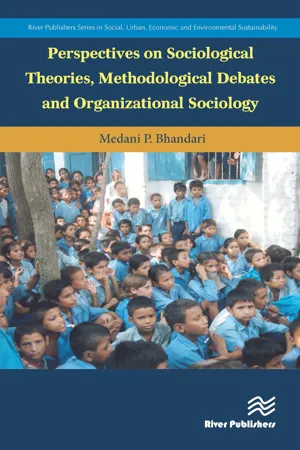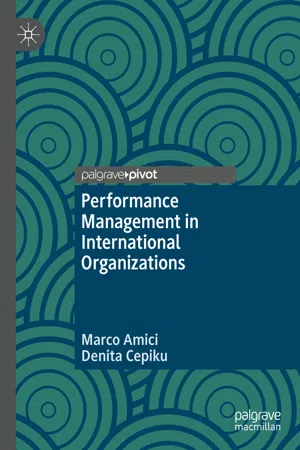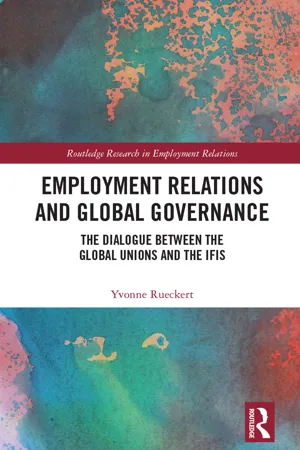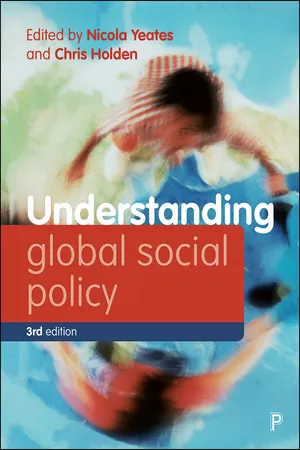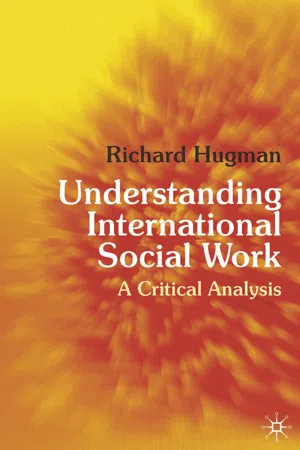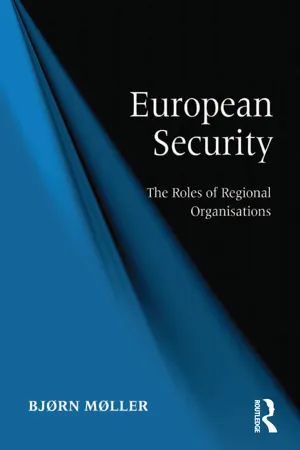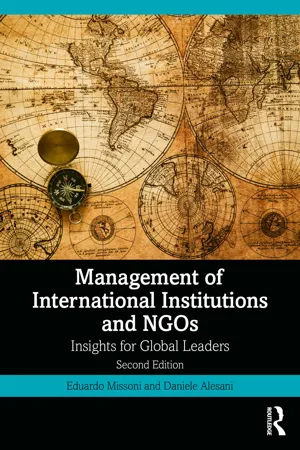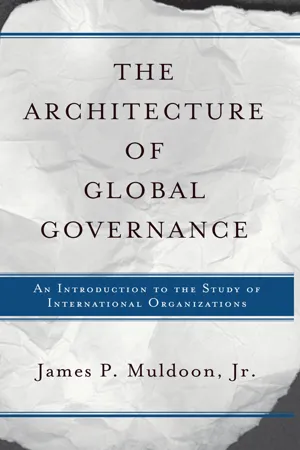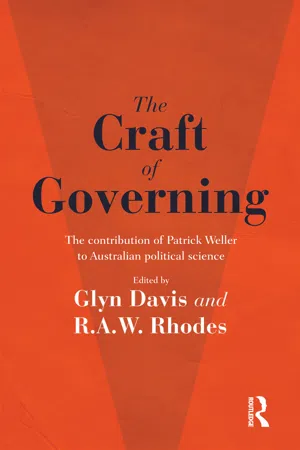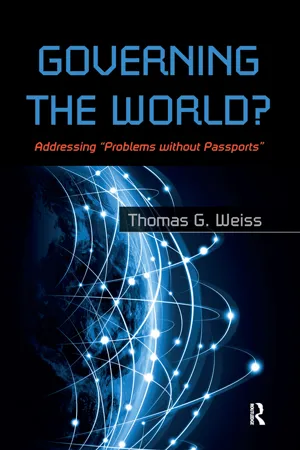Social Sciences
International Organisations
International organizations are entities formed by countries to address global issues and promote cooperation. They serve as platforms for diplomatic negotiations, policy development, and the implementation of international agreements. These organizations can focus on a wide range of areas, including economic development, human rights, environmental protection, and security.
Written by Perlego with AI-assistance
Related key terms
11 Key excerpts on "International Organisations"
- eBook - ePub
- Medani P. Bhandari(Author)
- 2023(Publication Date)
- River Publishers(Publisher)
Scholars of contemporary international organizations have been advocating interdisciplinary approaches (Friedrich Kratochwil, Michael Barnett, Martha Finnemore, Margaret Keck, and Kathryn Sikkink). They argue that the role of international organizations has been expanding from the state-centric framework to the people-centric perspective. In the current context, the study of international organizations not only covers nationstates, international regimes, and security alliances but also the international form of organizations that focus on non-state actors. In this context, the role of international organizations is not solely centered on the implementation of political agendas but also focuses on the social, cultural, and economic power dynamism. Therefore, the study of international organizations not only belongs to the political scientist but also to the sociologist and includes a range of social science discourses.Insofar, in this section, I tried to explain what we know about the study of international organizations and how international organization theories are associated (broadly) with sociological theories and especially with organizational sociology. In the following section, I will very briefly outline organizational sociology’s major approaches and try to connect with how these approaches can be applied to study international organizations.Organizational Sociology
“The study of organizations provides a theoretical framework for knowledge about human behavior in organizations and reviews the empirical evidence for the propositions that make up the theory. The theory emphasizes the motivations for organizational participation and the processes of decision making within organizations” (Simon 1979).Organizational sociology can be described as the study of formal groups organized to achieve or attain specific goals efficiently. Organizations have been leading the socio-political scenarios of the world for at least the last two centuries. In other words, organizations have been changing the world’s socioeconomic landscape (Perrow 1991). As Perrow notes, “organizations are the key to society because large organizations have absorbed society. They have vacuumed up a good part of what we have always thought of as society and made organizations once a part of society into a surrogate of society” (1991, page 726, as cited by Scott and Davis 2007, page 340). This influence, which has increased gradually over time, mostly in the developed regions of the world during the 20th century, can be found in our everyday lives. Now, we are in organizational firms from birth to joining the workforce, as well as in our prayers, and we even die in organizations; along the way, we derive our identities from our associations with them. Organizations are related to every aspect of our daily life. Organizations are not only the building blocks of our societies, and a basic vehicle for collective action, but they are also our life forms. They bring into being the social structure of our societies and form our futures. Organizations are a fundamental part of contemporary societies; we enthusiastically turn to them or create them when a need or crisis exceeds our person or resources. Moreover, organizations are at the core spirit of every society and nation. Through organizations, we make difference in our society and achieve collective goals. Theoretically, organizations are dedicated to extending the idea of creating a new base to create new opportunities. These broader contexts of organization theories apply not only to the domestic organizational environment but also, equally, apply in the case of international organizations. - eBook - ePub
International Social Work
Issues, Strategies, and Programs
- David R. Cox, Manohar Pawar(Authors)
- 2012(Publication Date)
- SAGE Publications, Inc(Publisher)
Chapter 15 International Organizations: Roles for Social Workers and Preparation of Social Workers for International Social WorkIntroduction
As a consequence in part of globalization processes, the scale and significance of global problems, and the opening up of national borders, an increasing number of social workers, alongside other development and human services professionals, are taking an interest in international social work career options. To facilitate and sustain that interest, in this chapter, we explore a range of international organizations from a career perspective. In Chapter 3 , we presented an overview of the organizational context of international social work. We shall now expand that overview by discussing a few examples of international organizations and the roles that social workers either commonly play, or can play, in them, for those interested in considering a career in the international field. We shall then turn to the question of social workers preparing themselves for international social work careers.Learning Objectives
- To develop some familiarity with the nature of international organizations
- To develop an understanding of the roles social workers can play in those organizations
- To discuss a few approaches to preparing social workers for international social work
- To be aware of some of the strategies used by social workers for effective international social work practice
International Organizations
Put simply, international organizations are those organizations that work in more than one nation-state/country. In various ways, most international organizations have to work with national and local organizations, and are therefore closely connected at national and local levels. However, these links between local and national organizations and international organizations—through, for example, the receipt of funding and other resources—does not make the former international, as they generally focus only at the national and local level. For consistency, we shall use the same five categories of international organizations used in Chapter 3 - Marco Amici, Denita Cepiku(Authors)
- 2020(Publication Date)
- Palgrave Pivot(Publisher)
4 although our analysis will main target their internal bureaucracy.2.2 Types, Scopes, Numbers and Functions of the International Organizations
Despite the attempt to use standard definitions to categorize international organizations, their universe is considerably heterogeneous due to their relevant differences in size, geographical scope, tasks, and functions. As for the size, the international organizations can include few members, three as in the case of the North America Free Trade Agreement (NAFTA), or a large number as the United Nations , which counts 193-member countries.5 Their geographical scope varies extensively from a specific area as the case of the regional organizations as ASEAN or the African Union, to worldwide organizations having members from all countries. Furthermore, there are single tasks organizations like the Organization for Petroleum Exporting (OPEC) as well as multipurpose organizations as the European Union or the United Nations. Consequently, their functions differ, as well. The most common include sharing and collecting information, monitoring trends, providing forums for collective decisions and, settling disputes (Karns et al. 2010 ). Again, how international organizations serve such functions vary extensively according to their rules, financial resources, level, and degree of bureaucratization (Karns et al. 2010 ). In the following table, a summary of the different main characteristics of international organizations is proposed (Table 2.2 ).Table 2.2 Types of international organizationsGeographical range International Organizations Global United Nations (UN) International Labour Organization (ILO) Food and Agricultural Organization (FAO) Regional ASEAN European Union Africa Union Sub-regional East African Community West Nordic Council Arab Maghreb Union Purpose International Organizations Multi-purpose United Nation European Union Single-purpose Nuclear Energy Agency International Organization for Migration (OIM) Source: based on Karns et al. (2010- eBook - ePub
Employment Relations and Global Governance
The Dialogue between the Global Unions and the IFIs
- Yvonne Rueckert(Author)
- 2023(Publication Date)
- Routledge(Publisher)
International relations theorists are not the only ones who are important for understanding international cooperation and global governance. Organisation theorists, especially from sociology, provide insights relevant to studying International Organisations as organisations.(Karns and Mingst, 2004 : 56)According to the selection of approaches within organisational sociology, different priorities can be set concerning the analysis of organisations. Sociological theories have the advantage that they ‘expect and explain a much broader range of impacts that organisations can have and specifically highlight their role in constructing actors, interests, and social purpose’ (Barnett and Finnemore, 1999 : 702). Organisations can be considered as open systems which engage with their environment, and their structures reflect broader societal developments and conditions. This is also true of International Organisations whose structures partly reflect global economic, political, and social (power) relations. The environment consists of different institutions and actors, which are continuously generating new stimuli for organisational action. On the one hand, the environment provides resources and opportunities to an organisation, and on the other hand, it contains constraints and demands which can be perceived as threats (Scott and Davis, 2007 : 19). Regarding the latter, International Organisations respond, for example, with the earlier mentioned democratic legitimation narratives. Generally, organisations assimilate the input from their environment in the form of information and convert such inputs according to the resources they have available and their organisational characteristics (Scott, 1998 ). The following sections consider some of these characteristics, including the organisational structure, identity and culture, knowledge and power, and organisational learning.Organisational structure
The structure of an organisation determines the character of the corporate actor and influences the actions of individual actors. Structural elements are job positions, policies, programmes, and procedures. These elements of the formal structure are a manifestation of powerful institutional rules which ‘function as highly rationalised myths that are binding on particular organisations’ (Meyer and Rowan, 1977 - Nicola Yeates, Chris Holden, Yeates, Nicola, Holden, Chris, Nicola Yeates, Chris Holden(Authors)
- 2022(Publication Date)
- Policy Press(Publisher)
We can see, therefore, that the concept of global governance goes beyond the idea of simple interactions between states within IGOs. IGOs are nevertheless particularly important to the global governance system. The following section looks in more detail at their roles and forms of organisation.Introduction to intergovernmental organisationsMost IGOs have their origins in the political settlement hammered out by the victorious powers at the end of the Second World War. In 1944, representatives from 44 allied states met in Bretton Woods , New Hampshire, at the UN Monetary and Financial Conference (informally known as the Bretton Woods Conference). The aim of this conference was to decide on a series of rules for a new international monetary system; the International Monetary Fund (IMF) and the World Bank were the result. Later the same year, delegates from China, the Soviet Union, the USA and the UK met in a private mansion in Washington DC named Dumbarton Oaks, to develop more ideas regarding a wider system of International Organisations that would facilitate global peace and prosperity. These were the foundations of the UN, and were ratified in 1945 when representatives of 50 countries met in San Francisco at the UN Conference on International Organization. From this was born the UN system, the ‘umbrella’ system for the majority of IGOs. Most IGOs operate as ‘specialised agencies’ within the UN system. From the outset, the institutions of global economic governance (see Chapter 3 , this volume), such as the IMF and the World Bank, were kept separate from those of global social governance. This separation has had far-reaching consequences for GSP and the extent to which global social and economic justice can be attained.Table 2.1 demonstrates that the majority of these institutions appear to have clear single-issue mandates. The WHO, for example, is concerned with global health; the WTO oversees global trade; the International Labour Organization (ILO) oversees labour and social protection- eBook - ePub
Understanding International Social Work
A Critical Analysis
- Richard Hugman(Author)
- 2010(Publication Date)
- Bloomsbury Academic(Publisher)
6 The Organizational Contexts of International Social Work International Social Work OrganizationsSocial work is overwhelmingly an agency-based profession. This is as much the case in the international field as it is in domestic practice. Consequently, to understand international social work it is necessary to examine the agencies and organizations within which social work is practised or which represent the profession of social work at the international level. In this chapter, therefore, we will examine three different types of organizations that are particularly significant for the field.The first type of organization to be considered is that of service providing INGOs. Social workers are employed in many of these organizations, in varying numbers, and much can be learned by considering the roles and tasks performed by social workers and which organizations they work in relative to which human needs. The second type of organization is the quasi-governmental or inter-governmental domain largely represented by the agencies of the UN, as well as the UN in itself. As we will see, social work has had a long and at times influential relationship with the UN although this has waned over time. The third type of organization to be considered is that of social work’s own international professional bodies, the IASSW, the ICSW and the IFSW, along with their regional associated organizations such as the Asia-Pacific Association of Social Work Education (APASWE). These latter organizations have been the site of the practice of international social work (understood in the various ways that have been presented in previous chapters), as well as representing the interests of social workers to governments and to international quasi-governmental and NGOs. - eBook - ePub
European Security
The Roles of Regional Organisations
- Bjørn Møller(Author)
- 2016(Publication Date)
- Routledge(Publisher)
Today the topic is rather international organisation (in the singular) and very little is published about organisations (in the plural), which are at most included as case studies for more general and/or abstract theories about multilateralism, regimes and the like (Rochester 1986; Verbeek 1998). On the other hand, even though the several journals which are more or less exclusively devoted to the European Union do provide space for analysis of its organisational features, most contributors treat the EU as something sui generis and they are generally very reluctant to generalise from their findings. The various journals devoted to organisations, public management and administration, in turn, focus almost exclusively on the national level and almost completely disregard International Organisations. Hence, the organisational features of International Organisations constitutes a rather under-researched field which is also reflected in the following pages, which are partly based on what is known about national organisations applied to International Organisations, even though the validity of this can by no means be taken for granted (Ness and Brechin 1988; Fisdick 2000). Organisational Parameters As organizations, international ones differ from each other along several parameters such as membership, structure and decision-making mode and legal status, all of which have a strong impact on the organisation’s strength (Rittberger and Zangl 2006). As far as membership is concerned, this is both a matter of the nature of the members and the inclusiveness of membership. Most International Organisations have exclusively states as members, but some also allow for some form of representation of non-state actors such as state-like polities (e.g. Taiwan or the Palestinian Authority), other International Organisations, NGOs or parts of the business community (vide infra) - eBook - ePub
Management of International Institutions and NGOs
Insights for Global Leaders
- Eduardo Missoni, Daniele Alesani(Authors)
- 2023(Publication Date)
- Routledge(Publisher)
1 International institutions Classification and main characteristics Daniele Alesani DOI: 10.4324/9781003289852-2 1.1 Introduction International institutions (IIs) are the result of the need for sovereign states to come together, as an international community, to promote cooperation, development, and social well-being, as well as ensuring Pacific co-existence. IIs have often been described as “clubs of states” for their constituencies are normally nation-states. IIs’ accountability to the individuals and communities that are the ultimate beneficiaries of their activities is usually mediated by political representation mechanisms. While treaties and alliances among states have existed for centuries, the establishment of formal IIs began in the nineteenth century. The history of international relations shows the first IIs were formed in the aftermath of the Napoleonic Wars. They were mainly focused on specific themes, such as the International Telecommunication Union (ITU), which is still in operation today. Of notable significance was the emergence of the League of Nations following World War I. This institution was designed to foster collective security in order to sustain peace. It is in the ashes of this experiment that the United Nations was created after World War II, along with the Bretton Woods institutions - eBook - ePub
The Architecture Of Global Governance
An Introduction To The Study Of International Organizations
- James P Muldoon, Jr.(Authors)
- 2018(Publication Date)
- Routledge(Publisher)
The international order we have today is the result of the interactions between and among states, markets, and civil society as they respond to environmental circumstances (such as war, technological innovations, and/or social needs) throughout the twentieth century. The international order that emerged after World War II was for the most part designed by the United States and reflected the American view of order. According to G. John Ikenberry, “the order that was envisioned for postwar relations among the industrial democracies—and hopefully for the larger world system—was inspired by liberal sentiments, an economic theory of war, and lessons drawn from the 1930s…. a postwar order that would ensure ‘economic peace’ based on free trade and investment, rules and mechanisms of joint economic management, and political institutions to facilitate the peaceful settlement of disputes.” (Ikenberry 1999, 24) The institutional framework that was designed by the major powers, particularly the United States, for the postwar international system sought to re-constitute a world order along familiar lines—to that of a modern democratic society. It gave states and their organizations the lead role in establishing and managing the order, but it also recognized that market actors (international business enterprises) in the private sector, and nongovernmental and private voluntary organizations in the civil society sector, had a role in building the organizational infrastructure of the international system.As it is on the national level, the international system is roughly divided between public and private spheres. The primary actors in the public sphere are states, while non-state actors constitute the private sphere. International institutions, particularly international organizations, closely mirror the relationships found in nation-states between the public and private spheres. However, the international level lacks a single or central global authority with the power to govern the system in the same way as the state on the national level; it is this characteristic that defines the way organizations of the international system have been designed and structured. The historical circumstances that permitted international organizations to emerge as outlined in the last chapter indicate that international order is the work of three inter-related societal groupings—nation-states and their governments, markets and businesses, and civil society (nongovernmental organizations and private voluntary organizations). Each group played a role in the organizational design and structure of the international system. Through reacting to and interacting with each other, an array of international economic, political, and social institutions have been constructed—including formal ones like laws and regulations, explicit contracts, and market exchange rules, and informal institutions such as common values, norms, customs, ethics and ideology. All “set the constraints within which tangible and non-tangible resources are used” and, in the end, enable things to get done in the world. (United Nations 2000, 210) - eBook - ePub
The Craft of Governing
The contribution of Patrick Weller to Australian political science
- R.A.W. Rhodes(Author)
- 2020(Publication Date)
- Routledge(Publisher)
The influence of economics on US political science is not news to any corner of the discipline, but international relations was (rather typically) a late adopter. Many of the areas of interest to Weller and Xu, such as free trade, guarding intellectual property, fighting pandemics, lender of last resort facilities and so on, came to be seen as examples of potential or actual market failure or collective action problems. International-relations scholars drew upon the writings of economists such as George Akerloff, Mancur Olson and Charles Kindleberger in both framing their understanding of such problems, and in considering solutions. The goals of non-security International Organisations came to be seen as public goods, and the major obstacle to providing these goods was held to be states’ tendency to free-ride, failing to bear their share of the costs involved. The potential solution was argued to be mechanisms that monitor and exclude free-riding states from the benefits of future cooperation, thus overcoming the short-term incentive to free-ride by consuming but not contributing to public goods (Axelrod 1984; Keohane 1984; Oye 1986). International Organisations could play just this role, whether it was the General Agreement on Tariffs and Trade or the World Intellectual Property Organization. In this rendering, though International Organisations were definitely the instruments of states, they nevertheless played a vitally important role in fostering and maintaining cooperation that individual states could not manage in isolation.A further development of this rational-choice-inspired scholarship granted an important measure of autonomy to International Organisations, based on the principal–agent framework first developed to explain the relationship between shareholders and company managers. Of course, principal–agent work based on the key concepts of goal diversity and information asymmetry is well known to scholars of public policy for modelling the relationship between voters and elected politicians, or even more so between elected politicians and bureaucrats. In the international relations version, states are the principals that create and fund International Organisations, while the IOs themselves are the agents who enjoy de facto autonomy, thanks to their superior detailed knowledge of the task at hand and their own efforts to complete it (Nielson and Tierney 2003; Hawkins et al. 2006). IOs are vested with some significant political autonomy in pursuing their own goals, rather than being just unthinking tools of states. As detailed below, this picture is much closer to Weller and Xu’s version of IOs as genuine political entities worth studying in their own right, and not mere talk shops, or arenas for negotiation, or instruments of states. The cover of one of the major volumes of this principal–agent work references the metaphor noted earlier by having a stylised puppet cutting the strings held by the puppeteer. A particular focus of those working from a principal–agent perspective is the special challenges faced by a collective principal, i.e. rather than just one minister running a department, a group of perhaps dozens of states hold their ostensible servants accountable. - eBook - ePub
Governing the World?
Addressing "Problems Without Passports"
- Thomas G Weiss(Author)
- 2015(Publication Date)
- Routledge(Publisher)
The past quarter century has witnessed a sea-change in knowledge, norms, and policies to address some of the planet’s ills. We are not starting from scratch. Yet steps in the right direction must find a home within effective institutional structures if responses are to avoid being ad hoc, episodic, idiosyncratic, and ultimately inadequate. Collective efforts backed with financial resources and qualified people have clout, whereas those without do not.There exists a theoretical distinction between “organization” and “institution.” Oran Young tells us that “organizations” are material entities, “possessing physical locations (or seats), offices, personnel, equipment, and budgets.”1 For many specialists, the word “institutions” is not a synonym for “organizations.” Konrad von Moltke views “institutions” as “social conventions or ‘rules of the game,’ in the sense that marriage is an institution, or property, markets, research, transparency or participation.”2 However, a more commonsense use of both terms is structures reinforced by rules and norms, which is why most nonspecialist audiences and virtually all media accounts employ the two terms interchangeably.The emphasis here is on the weaknesses or absence of formal structures, backed by public international law and norms, for coordinating state decision making and action. In short, we need global IGOs, especially ones with universal membership, that work. Before building the next generation of such structures, however, three widespread construction myths should be demolished.Myth 1: Only States Wield Power
As we know, the starting point for virtually all analyses of world politics is the centrality of sovereignty and the role of states that exercise their hard (coercive) and soft (attractive) power. IGOs have tasks delegated to them by states, whose whims often determine their focus. Such organizations are functionally reduced to their technical accomplishments and their staff to puppets. Every first-term student of international relations is taught that states are powerful, IGOs are not; states are principals, IGOs are agents. Meanwhile TNCs and NGOs are subject to the authority of the states in which they are incorporated and operate.
Index pages curate the most relevant extracts from our library of academic textbooks. They’ve been created using an in-house natural language model (NLM), each adding context and meaning to key research topics.
